Miyamoto Musashi
Miyamoto Musashi (宮本 武蔵, March 12, 1584, Ōhara-Chō, – June 13, 1645)[1], also known as Shinmen Takezō, Miyamoto Bennosuke or, by his Buddhist name, Niten Dōraku,[2] was a Japanese swordsman, philosopher, strategist, writer and rōnin. Musashi, as he was often simply known, became renowned through stories of his unique double-bladed swordsmanship and undefeated record in his 61 duels (next is 33 by Itō Ittōsai). He is considered a Kensei, a sword-saint of Japan.[3] He was the founder of the Niten Ichi-ryū school or Nito Ichi-ryū style of swordsmanship, and in his final years authored The Book of Five Rings (五輪の書, Go Rin No Sho), and Dokkōdō (The Path of Aloneness). Both documents were given to Terao Magonojō, the most important of Musashi's students, seven days before Musashi's death. The Book of Five Rings deals primarily with the character of his Niten Ichi-ryū school in a concrete sense e.g. his own practical martial art and its generic significance; The Path of Aloneness on the other hand, deals with the ideas that lie behind it, as well as his life's philosophy in a few short aphoristic sentences. The Miyamoto Musashi Budokan training center - in a remarkable architecture - located in Ōhara-chō (Mimasaka), Okayama prefecture, Japan was erected to honor his name and legend.
| Miyamoto Musashi | |||||
|---|---|---|---|---|---|
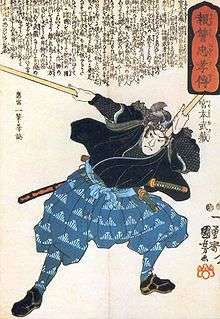 Miyamoto Musashi in his prime, wielding two bokken. Woodblock print by Utagawa Kuniyoshi. | |||||
| Born | Miyamoto Bennosuke c. 1584 Harima Province or Mimasaka Province, Japan | ||||
| Died | 13 June 1645 (aged 60–61) Higo Province, Japan | ||||
| Native name | 宮本武蔵 | ||||
| Other names | Niten Dōraku; Shinmen Musashi no Kami Fujiwara no Harunobu | ||||
| Residence | Japan | ||||
| Style | Hyōhō Niten Ichi-ryū Kenjutsu (二天一流), Enmei-ryu (圓明流), (二天流) | ||||
| Notable students | Takemura Yoemon; Terao Magonojō; Terao Motomenosuke; Furuhashi Sōzaemon | ||||
| Japanese name | |||||
| Kanji | 宮本 武蔵 | ||||
| Hiragana | みやもと むさし | ||||
| Katakana | ミヤモト ムサシ | ||||
| |||||
Biography
Birth

The details of Miyamoto Musashi's early life are difficult to verify. Musashi himself simply states in The Book of Five Rings that he was born in Harima Province.[5] Niten Ki (an early biography of Musashi) supports the theory that Musashi was born in 1584: "[He] was born in Banshū, in Tenshō 12 [1584], the Year of the Monkey."[6] The historian Kamiko Tadashi, commenting on Musashi's text, notes: "Munisai was Musashi's father ... he lived in Miyamoto village, in the Yoshino district [of Mimasaka Province]. Musashi was most probably born here."[7] His childhood name was Bennosuke (弁之助), and his father worked as a farmer. "Bennosuke" often worked the fields there before his restless nature eventually led him to the life of the sword.
Musashi gives his full name and title in The Book of Five Rings as Shinmen Musashi-no-Kami Fujiwara no Harunobu (新免武蔵守藤原玄信).[8] His father, Shinmen Munisai (新免無二斎) was an accomplished martial artist and master of the sword and jutte (also jitte).[7] Munisai, in turn, was the son of Hirata Shōgen (平田将監), a vassal of Shinmen Iga no Kami, the lord of Takayama Castle in the Yoshino district of Mimasaka Province.[9] Hirata was relied upon by Lord Shinmen and so was allowed to use the Shinmen name. As for "Musashi", Musashi no Kami was a court title, making him the nominal governor of Musashi Province. "Fujiwara" was the lineage from which Musashi claimed descent.
Munisai and Musashi's birth date
Munisai's tomb says he died in 1580, which conflicts with the commonly accepted birth date of 1584 for Musashi. Further confounding his birthdate, the genealogy of the extant Miyamoto family recounts Musashi was born in 1582. Kenji Tokitsu has suggested that the accepted birth date of 1584 for Musashi is wrong, as it is primarily based on a literal reading of the introduction to The Book of Five Rings where Musashi states that the years of his life "add up to 60" (yielding the twelfth year of the Tensho era, or 1584, when working backwards from the well-documented date of composition), when it should be taken in a more literary and imprecise sense, indicating not a specific age but merely that Musashi was in his sixties when he wrote it. He may have also written it two years prior to when it was considered a composition.
There is considerable uncertainty surrounding Munisai, such as when he died and whether he was truly Musashi's father, and even less is known about Musashi's mother. The following are a few possibilities:
- Munisai's tomb was correct. He died in 1580, leaving two daughters and son Iori; his wife adopted a recently born child, from the Akamatsu clan, intended to succeed Munisai at his jitte school. Omasa, Munisai's widow, was not Musashi's biological mother.
- The tomb was wrong. Munisai lived a good deal longer, later than 1590 possibly. Musashi, then, was born to Munisai's first wife, Yoshiko (daughter to Bessho Shigeharu, who formerly controlled Hirafu village until he lost a battle in 1578 to Yamanaka Shikanosuke). Munisai divorced her after Musashi's birth, whereupon she decamped for her father's house, leaving Musashi with Munisai. Musashi grew up treating Munisai's second wife, Omasa (daughter to Lord Shinmen) as his mother. This second scenario is laid out in an entry to the Tasumi family's genealogy. The daughter of Bessho Shigeharu first married Hirata Munisai and was divorced from him a few years later. After that she married Tasumi Masahisa. The second wife of Tasumi Masahisa was the mother of Miyamoto Musashi. Musashi's childhood name was Hirata Den. During his childhood, he went to Hirafu to find his real mother. He moved in with the Tasumi family.[10]
- A variant of this second theory is based on the fact that the tombstone states that Omasa gave birth to Musashi on 4 March 1584, and died of it. Munisai then remarried to Yoshiko. They divorced, as in the second theory, but Yoshiko took Musashi, who was 7 at the time, with her, and married Tasumi Masahisa.
- Kenji Tokitsu prefers to assume a birth date of 1581, which avoids the necessity of assuming the tombstone to be erroneous (although this poses the problem of from whom then Musashi received the transmission of the family martial art).
- There is another possibility that Munisai's tomb was correct he died in near the end of 1580 but also got Omasa pregnant near the time of his death and had the baby in 1582 because she had her pregnancy which was a couple weeks late, and had Musashi within January or February meaning the Miyamoto family was correct and she hid him from everyone till 1584. Miyamoto Musashi was told he was born in 1584 to another man so he stated in The Book of Five Rings that he was born in 1584. He had received his training from his uncle.
Upbringing
Regardless of the truth about Musashi's ancestry, when Musashi was seven years old, the boy was raised by his uncle, Dorinbo (or Dorin), in Shoreian temple, three kilometers (~1.8 mi.) from Hirafuku. Both Dorin and Tasumi, Musashi's uncle by marriage, educated him in Buddhism and basic skills such as writing and reading. This education is possibly the basis for Yoshikawa Eiji's fictional education of Musashi by the historical Zen monk Takuan. He was apparently trained by Munisai in the sword, and in the family art of the jutte. This training did not last for a very long time, as in 1589, Munisai was ordered by Shinmen Sokan to kill Munisai's student, Honiden Gekinosuke. The Honiden family was displeased, and so Munisai was forced to move four kilometers (~2.5 mi.) away to the village of Kawakami.
In 1592, Munisai died, although Tokitsu believes that the person who died at this time was really Hirata Takehito.
Musashi contracted eczema in his infancy, and this adversely affected his appearance.[11] Another story claims that he never took a bath because he did not want to be surprised unarmed. While the former claim may or may not have some basis in reality, the latter seems improbable.[12] An unwashed member of the warrior caste would not have been received as a guest by such houses as Honda, Ogasawara, and Hosokawa. These and many other details are likely embellishments that were added to his legend, or misinterpretations of literature describing him.
His father's fate is uncertain, but it is thought that he died at the hands of one of Musashi's later adversaries, who was punished or even killed for treating Musashi's father badly. However, there are no exact details of Musashi's life, since Musashi's only writings are those related to strategy and technique.
Training in swordsmanship
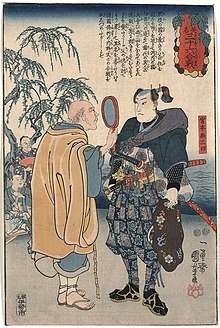
The name "Musashi" was thought to be taken from the name of a warrior monk named Musashibō Benkei who served under Minamoto no Yoshitsune, but this is unconfirmed.
It is said that he may have studied at the Yoshioka-ryū school, which was also said to be the school Musashi defeated single-handedly during his later years, although this is very uncertain. He did have formal training either by his father until he was seven years old or from his uncle beginning at the age of seven. Ultimately the name was taken from his own original kanji characters, 武蔵, which can be read as Takezō or as Musashi, as stated in Eiji Yoshikawa's book Musashi.
First duel
I have trained in the way of strategy since my youth, and at the age of thirteen I fought a duel for the first time. My opponent was called Arima Kihei, a sword adept of the Shinto ryū, and I defeated him. At the age of sixteen I defeated a powerful adept by the name of Akiyama, who came from Tajima Province. At the age of twenty-one I went up to Kyōtō and fought duels with several adepts of the sword from famous schools, but I never lost.
— Miyamoto Musashi, Go Rin No Sho
According to the introduction of The Book of Five Rings, Musashi states that his first successful duel was at the age of 13, against a samurai named Arima Kihei who fought using the Kashima Shintō-ryū style, founded by Tsukahara Bokuden (b. 1489, d. 1571). The main source of the duel is the Hyoho senshi denki ("Anecdotes about the Deceased Master"). Summarized, its account goes as follows:
In 1596, Musashi was 13, and Arima Kihei, who was traveling to hone his art, posted a public challenge in Hirafuku-mura. Musashi wrote his name on the challenge. A messenger came to Dorin's temple, where Musashi was staying, to inform Musashi that his duel had been accepted by Kihei. Dorin, Musashi's uncle, was shocked by this, and tried to beg off the duel in Musashi's name, based on his nephew's age. Kihei was adamant that the only way his honour could be cleared was if Musashi apologized to him when the duel was scheduled. So when the time set for the duel arrived, Dorin began apologizing for Musashi, who merely charged at Kihei with a six-foot quarterstaff, shouting a challenge to Kihei. Kihei attacked with a wakizashi, but Musashi threw Kihei on the floor, and while Kihei tried to get up, Musashi struck Arima between the eyes and then beat him to death. Arima was said to have been arrogant, overly eager to battle, and not a terribly talented swordsman.
Travels and duels
In 1599, Musashi left his village, apparently at the age of 15 (according to the Tosakushi, "The Registry of the Sakushu Region", although the Tanji Hokin Hikki says he was 16 years old in 1599, which agrees time-wise with the age reported in Musashi's first duel).[10] His family possessions such as furniture, weapons, genealogy, and other records were left with his sister and her husband, Hirao Yoemon.
He spent his time traveling and engaging in duels, such as with an adept called Akiyama from the Tajima Province.
In 1600, when a war began between the Toyotomi and Tokugawa clans, Musashi apparently fought on the side of the Toyotomi's "Army of the West", as the Shinmen clan (to whom his family owed allegiance) had allied with them. Specifically, he participated in the attempt to take Fushimi castle by assault in July 1600, in the defense of the besieged Gifu Castle in August of the same year, and finally in the Battle of Sekigahara. Some doubt has been cast on this final battle, as the Hyoho senshi denki has Musashi saying he is "no lord's vassal" and refusing to fight with his father (in Lord Ukita's battalion) in the battle. Omitting the Battle of Sekigahara from the list of Musashi's battles would seem to contradict The Book of Five Rings's statement that Musashi fought in six battles, however. Regardless, as the Toyotomi side lost, it has been suggested that Musashi fled as well and spent some time training on Mount Hiko.
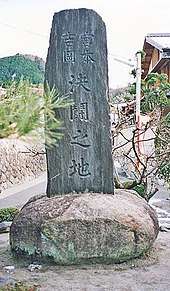

After the battle, Musashi disappears from the records for a while. The next mention of him has him arriving in Kyoto at the age of 20 (or 21), where he began a series of duels against the Yoshioka School. Musashi's father, Munisai, also fought against a master of the Yoshioka school and won 2 out of 3 bouts in front of the shōgun at the time, Ashikaga Yoshiaki who granted him the title of "Unrivaled Under Heaven". The Yoshioka School (descended from either the Tenshin Shōden Katori Shintō-ryū or the Kyo-hachi-ryū) was the foremost of the eight major schools of martial arts in Kyoto, the "Kyo-ryū" / "Schools of Kyoto". Legend has it that these eight schools were founded by eight monks taught by a legendary martial artist resident on the sacred Mount Kurama. At some point, the Yoshioka family also began to make a name for itself not merely in the art of the sword but also in the textile business and for a dye unique to them. They gave up teaching swordsmanship in 1614 when they fought in the Army of the West against Tokugawa Ieyasu in the Battle of Osaka, which they lost. But in 1604, when Musashi began duelling them, they were still preeminent. There are various accounts of the duels—the Yoshioka family documents claim that there was only one, against Yoshioka Kenpō, which Musashi, once again, won.
Musashi challenged Yoshioka Seijūrō, master of the Yoshioka School, to a duel. Seijūrō accepted, and they agreed to a duel outside Rendaiji in Rakuhoku, in the northern part of Kyoto on 8 March 1604. Musashi arrived late, greatly irritating Seijūrō. They faced off, and Musashi struck a single blow, per their agreement. This blow struck Seijūrō on the left shoulder, knocking him out, and crippling his left arm. He apparently passed on the headship of the school to his equally accomplished brother, Yoshioka Denshichirō, who promptly challenged Musashi for revenge. The duel took place in Kyoto outside a temple, Sanjūsangen-dō. Denshichirō wielded a staff reinforced with steel rings (or possibly with a ball-and-chain attached), while Musashi arrived late a second time. Musashi disarmed Denshichirō and defeated him. This second victory outraged the Yoshioka family, whose head was now the 12-year-old Yoshioka Matashichiro. They assembled a force of archers, musketeers and swordsmen, and challenged Musashi to a duel outside Kyoto, near Ichijō-ji Temple. Musashi broke his previous habit of arriving late, and came to the temple hours early. Hidden, Musashi assaulted the force, killing Matashichiro, and escaping while being attacked by dozens of his victim's supporters. To escape and fight off his opponents he was forced to draw his second sword and defend himself with a sword in each hand. This was the beginning of his niten'ichi sword style. With the death of Matashichiro, this branch of the Yoshioka School was destroyed.
After Musashi left Kyoto, some sources recount that he travelled to Hōzōin in Nara, to duel with and learn from the monks there, widely known as experts with lance weapons. There he settled down at Enkoji Temple in Banshū, where he taught the head monk's (one Tada Hanzaburo's) brother. Hanzaburo's grandson would found the Ensu-ryū based on the Enmei-ryū teachings and iaijutsu.
From 1605 to 1612, he travelled extensively all over Japan in musha shugyō, a warrior pilgrimage during which he honed his skills with duels. He was said to have used bokken or bokuto in actual duels. Participants in most of the engagements from these times did not try to take the opponent's life unless both agreed, but in most duels, it is known that Musashi did not care which weapon his foe used—such was his mastery.
A document dated 5 September 1607, purporting to be a transmission by Miyamoto Munisai of his teachings, suggests Munisai lived at least to this date. In this year, Musashi departed Nara for Edo, during which he fought (and killed) a kusarigama practitioner named Shishido Baiken. In Edo, Musashi defeated Musō Gonnosuke, who would found an influential staff-wielding school known as Shintō Musō-ryū. Records of this first duel can be found in both the Shinto Muso-ryu tradition and the Hyōhō Niten Ichi-ryū (Miyamoto Musashi's school). The Shinto Muso Ryu tradition states that, after being defeated by Musashi, Muso Gonnosuke spent time developing a stick-fighting technique to counter swords and beat Musashi in a rematch. There are no current reliable sources outside the Shinto Muso Ryu tradition to confirm that this second duel took place.
Duel with Sasaki Kojirō
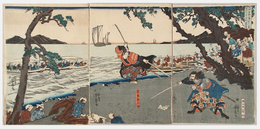
In 1611, Musashi began practicing zazen at the Myōshin-ji temple, where he met Nagaoka Sado, vassal to Hosokawa Tadaoki; Tadaoki was a powerful lord who had received the Kumamoto Domain in west-central Kyūshū after the Battle of Sekigahara. Munisai had moved to northern Kyūshū and became Tadaoki's teacher, leading to the possibility that Munisai introduced Musashi to Sasaki Kojirō, another guest of the Hosokawa clan at the time. Somehow, a duel was proposed between the two; in some versions, Nagaoka proposed the duel, in others with Sasaki proposed it out of rivalry or jealously. Tokitsu believes that the duel was politically motivated, as a matter of consolidating Tadaoki's control over his fief.
The duel was scheduled for April 13, 1612, when Musashi was approximately 30 years old. The departure by boat for the duel was arranged for the Hour of the Dragon in the early morning (approximately 8:00 AM) to the island of Ganryūjima, a small isle between Honshū and Kyūshū. While Hosokawa officials banned spectators, the island was filled with them anyway. Sasaki Kojirō was known for wielding an oversized nodachi (Japanese greatsword) called a "washing pole" for its length, as well as being titled "three-shaku silver blade" (「三尺の白刃」). Sasaki's signature technique was a swift yet powerful overhead slash, the tsubame gaeshi, and he bore the nickname "The Demon of the Western Provinces". Sasaki arrived at the appointed time, but was then left to wait for hours; Musashi had overslept. (In some variants of the tale, Musashi intentionally arrives late as a sign of disrespect.) As he sailed over the Kanmon Straits, Musashi carved a crude oversized bokken from one of the ship's oars with his knife, making an improvised wooden sword, possibly to help wake himself up. Upon his arrival, an irritated Sasaki chided Musashi's lateness and dramatically threw his scabbard into the sea, as a sign that he would not stop and would fight to the death. Musashi responded with a taunt of his own, saying that Sasaki clearly wasn't confident in himself if he thought he'd never get a chance to use a fine scabbard again.[14][15]
The two circled each other, and Sasaki leaped toward Musashi with his trademark overhead strike. Musashi, too, jumped and swung his weapon with a shout, and the two sword strokes met. Musashi's headband fell off, sliced by Sasaki's sword, but miraculously only the headband was cut rather than Musashi's skull. Musashi's strike, meanwhile, had struck true, crushing Sasaki's skull. The duel was quite short.[14]
Many variants of the tale exist, some almost assuredly written by people with no first-hand knowledge and apocryphal. In some versions, Musashi wields two swords. In other versions, Musashi uses a normal steel katana or katanas rather than wooden bokken(s). In another version, Musashi arrived to the "duel" with 4 armed retainers and easily mobbed the outnumbered Sasaki in a lopsided battle. Musashi's late arrival is also controversial. Sasaki's outraged supporters thought it was dishonourable and disrespectful, while Musashi's supporters thought it was a fair way to unnerve his opponent, or was unintentional. Another theory is that Musashi timed the hour of his arrival to match the turning of the tide. The tide carried him to the island. After his victory, Musashi immediately jumped back in his boat and his flight from Sasaki's vengeful allies was helped by the turning of the tide. Another theory states he waited for the sun to get in the right position. After he dodged a blow, Sasaki was blinded by the sun.
Musashi briefly established a fencing school later in 1612 after the duel.
Service
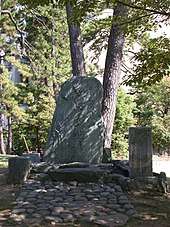
In 1614–1615, Musashi participated in the war between the Toyotomi and the Tokugawa. The war had broken out because Tokugawa Ieyasu saw the Toyotomi family as a threat to his rule of Japan; most scholars believe that, as in the previous war, Musashi fought on the Toyotomi side. Osaka Castle was the central place of battle. The first battle (the Winter Battle of Osaka; Musashi's fourth battle) ended in a truce. The second (the Summer Battle of Osaka; Musashi's fifth battle) resulted in the total defeat of Toyotomi Hideyori's Army of the West by Ieyasu's Army of the East in May 1615. Some reports go so far as to say that Musashi entered a duel with Ieyasu, but was recruited after Ieyasu sensed his defeat was at hand. This may seem unlikely since Ieyasu was in his 70s and was in poor health already, but it remains unknown how Musashi came into Ieyasu's good graces.
Other claims he actually served on the Tokugawa side are unproven, although Musashi had a close relationship with some Tokugawa vassals through his duel with Sasaki Kojirō, and in the succeeding years, he did not drop out of sight as might be expected if he were being persecuted for being on the losing side. In his later years, Ogasawara and Hosokawa supported Musashi greatly—an atypical course of action for these Tokugawa loyalists, if Musashi had indeed fought on behalf of the Toyotomi.
In 1615 he entered the service of Ogasawara Tadanao (小笠原忠直) of Harima Province, at Ogasawara's invitation, as a "Construction Supervisor," after previously gaining skills in craft. He helped construct Akashi Castle and in 1621 to lay out the organisation of the town of Himeji. He also taught martial arts during his stay, specializing in instruction in the art of shuriken(ninja-star)-throwing. During this period of service, he adopted a son.
In 1621, Musashi defeated Miyake Gunbei and three other adepts of the Togun-ryu in front of the lord of Himeji; it was after this victory that he helped plan Himeji. Around this time, Musashi developed a number of disciples for his Enmei-ryū although he had developed the school considerably earlier; at the age of 22, Musashi had already written a scroll of Enmei-ryū teachings called "Writings on the Sword Technique of the Enmei-ryū" (Enmei-ryū kenpō sho). 円/"En" meant "circle" or "perfection"; 明/"mei" meant "light"/"clarity", and 流/"ryū" meant "school"; the name seems to have been derived from the idea of holding the two swords up in the light so as to form a circle. The school's central idea is given as training to use the twin swords of the samurai as effectively as a combination of sword and jutte.
In 1622, Musashi's adoptive son, Miyamoto Mikinosuke, became a vassal to the Himeji Domain. Possibly this prompted Musashi to leave, embarking on a new series of travels, winding up in Edo in 1623, where he became friends with the Confucian scholar Hayashi Razan, who was one of the Shōgun's advisors. Musashi applied to become a swordmaster to the shōgun, but as he already had two swordmasters (Ono Jiroemon Tadaaki and Yagyū Munenori—the latter also a political advisor, in addition to his position as the head of the Shogunate's secret police) Musashi's application was denied. He left Edo in the direction of Ōshū, ending up in Yamagata, where he adopted a second son, Miyamoto Iori. The two then travelled, eventually stopping in Osaka.
In 1626, Miyamoto Mikinosuke, following the custom of junshi, performed seppuku because of the death of his lord. In this year, Miyamoto Iori entered Lord Ogasawara's service. Musashi's attempt to become a vassal to the lord of Owari, like other such attempts, failed.
In 1627, Musashi began to travel again. In 1634 he settled in Kokura with Iori, and later entered the service of the daimyō Ogasawara Tadazane, taking a major role in the Shimabara Rebellion. Iori served with distinction in putting down the rebellion and gradually rose to the rank of karō – a position equal to a minister. Musashi, however was reputedly injured by a thrown rock while scouting in the front line, and was thus unnoticed.
Later life

Six years later, in 1633, Musashi began staying with Hosokawa Tadatoshi, daimyō of Kumamoto Castle, who had moved to the Kumamoto fief and Kokura, to train and paint[16]. The Hosokawa sided with Tokugawa Ieyasu during the decisive Sekigahara Campaign, and thus were made fudai (inside) daimyō under the Tokugawa shogunate, they were given Higo Province, with an income of 540,000 koku, as their han (fief).
Ironically, it was at this time that the Hosokawa lords were also the patrons of Musashi's chief rival, Sasaki Kojirō. While he engaged in very few duels; one would occur in 1634 at the arrangement of Lord Ogasawara, in which Musashi defeated a lance specialist by the name of Takada Matabei. Musashi would officially become the retainer of the Hosokowa lords of Kumamoto in 1640. The Niten Ki records "[he] received from Lord Tadatoshi: 17 retainers, a stipend of 300 koku, the rank of ōkumigashira 大組頭, and Chiba Castle in Kumamoto as his residence."[17]
 Statue of Hosokawa Tadatoshi within Suizen-ji Jōju-en.
Statue of Hosokawa Tadatoshi within Suizen-ji Jōju-en.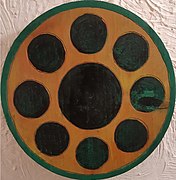 Mon of the Hosokawa clan.
Mon of the Hosokawa clan.
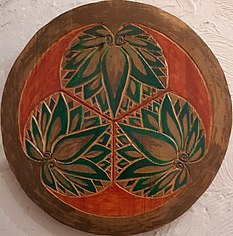
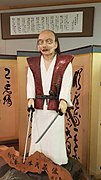 Statue of Miyamoto Musashi à Ōhara-chō.
Statue of Miyamoto Musashi à Ōhara-chō.

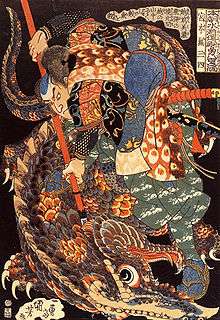

In the second month of 1641, Musashi wrote a work called the Hyoho Sanju Go ("Thirty-five Instructions on Strategy") for Hosokawa Tadatoshi, this work overlapped and formed the basis for the later The Book of Five Rings. This was the year that his third son, Hirao Yoemon, became Master of Arms for the Owari fief. In 1642, Musashi suffered attacks of neuralgia, foreshadowing his future ill-health. In 1643 he retired to a cave named Reigandō as a hermit to write The Book of Five Rings. He finished it in the second month of 1645. On the twelfth of the fifth month, sensing his impending death, Musashi bequeathed his worldly possessions, after giving his manuscript copy of The Book of Five Rings to the younger brother of Terao Magonojo, his closest disciple. He died in Reigandō cave around June 13, 1645 (Shōhō 2, 19th day of the 5th month). The Hyoho senshi denki described his passing:
At the moment of his death, he had himself raised up. He had his belt tightened and his wakizashi put in it. He seated himself with one knee vertically raised, holding the sword with his left hand and a cane in his right hand. He died in this posture, at the age of sixty-two. The principal vassals of Lord Hosokawa and the other officers gathered, and they painstakingly carried out the ceremony. Then they set up a tomb on Mount Iwato on the order of the lord.
Miyamoto Musashi died of what is believed to be thoracic cancer.[20] He died peacefully after finishing the text Dokkōdō ("The Way of Walking Alone", or "The Way of Self-Reliance"), 21 precepts on self-discipline to guide future generations.
His body was interred in armour within the village of Yuge, near the main road near Mount Iwato, facing the direction the Hosokawas would travel to Edo; his hair was buried on Mount Iwato itself. (NB - Mount Iwato is part of the Mount Kinpu range in Kumamoto and actually where Musashi wrote The Book of Five Rings in the Reigando cave. His grave is not there, but about 45 minutes away, to the east and on the other side of Kumamoto, in the Musashizuka area). Some of his remains were given to Mimasaka so that he could be buried (in part) with his parents. The Mimasaka graves are located in the precincts of Musashi Shrine.
Nine years later, a major source about his life—a monument with a funereal eulogy to Musashi—was erected in Kokura by Miyamoto Iori; this monument was called the Kokura hibun. An account of Musashi's life, the Niten-ki 二天記, was published in Kumamoto in 1776, by Toyota Kagehide, based on the recollections of his grandfather Toyota Masataka, who was a second generation pupil of Musashi.
Teachings
Musashi created and refined a two-sword kenjutsu technique called niten'ichi (二天一, "two heavens as one") or nitōichi (二刀一, "two swords as one") or 'Niten Ichi-ryū' (A Kongen Buddhist Sutra refers to the two heavens as the two guardians of Buddha). In this technique, the swordsman uses both a large sword, and a "companion sword" at the same time, such as a katana with a wakizashi.[21]
The two-handed movements of temple drummers may have inspired him, although it could be that the technique was forged through Musashi's combat experience. Jutte techniques were taught to him by his father—the jutte was often used in battle paired with a sword; the jutte would parry and neutralize the weapon of the enemy while the sword struck or the practitioner grappled with the enemy. Today Musashi's style of swordsmanship is known as Hyōhō Niten Ichi-ryū.[22]
Musashi was also an expert in throwing weapons. He frequently threw his short sword, and Kenji Tokitsu believes that shuriken methods for the wakizashi were the Niten Ichi Ryu's secret techniques.[23]
Musashi spent many years studying Buddhism and swordsmanship. He was an accomplished artist, sculptor, and calligrapher. Records also show that he had architectural skills. Also, he seems to have had a rather straightforward approach to combat, with no additional frills or aesthetic considerations. This was probably due to his real-life combat experience; although in his later life, Musashi followed the more artistic. He made various Zen brush paintings, calligraphy, and sculpted wood and metal. Even in The Book of Five Rings he emphasizes that samurai should understand other professions as well. It should be understood that Musashi's writings were very ambiguous, and translating them into English makes them even more so; that is why so many different translations of The Book of Five Rings can be found. To gain further insight into Musashi's principles and personality, one could read his other works, such as Dokkōdō and Hyoho Shiji ni Kajo.
Timeline
The following timeline follows, in chronological order (of which is based on the most accurate and most widely accepted information), the life of Miyamoto Musashi.
| Date | Age | Occurrence |
|---|---|---|
| 1578 | −6 | Musashi's brother, Shirota, is born. |
| 1584 | 0 | Miyamoto Musashi is born. |
| 1591 | 7 | Musashi is taken and raised by his uncle as a Buddhist. |
| 1596 | 13 | Musashi duels with Arima Kihei in Hirafuku, Hyōgo Prefecture. |
| 1599 | 15 | Duels with a man named Akiyama in the northern part of Hyōgo Prefecture. |
| 1600 | 16 | Believed to have fought in the Battle of Sekigahara as part of the western army. Whether he actually participated in the battle is currently in doubt. |
| 1604 | 20 | Musashi has three matches with the Yoshioka clan in Kyoto. (1) Match with Yoshioka Seijuro in Yamashiro Province, outside the city at Rendai Moor (west of Mt. Funaoka, Kita-ku, Kyoto). (2) Match with Yoshioka Denshichiro outside the city. (3) Match with Yoshioka Matashichiro outside the city at the pine of Ichijō-ji. |
| 1604 | 20 | Visits Kōfuku-ji, Nara and ends up dueling with the Buddhist priest trained in the style of Hōzōin-ryū. |
| 1605–1612 | 21–28 | Begins to travel again. |
| 1607 | 23 | Munisai (Musashi's father) passes his teachings onto Musashi. |
| 1607 | 23 | Duels with the kusarigama expert Shishido Baiken in the western part of Mie Prefecture. |
| 1608 | 24 | Duels Musō Gonnosuke, master of the five-foot staff in Edo. |
| 1610 | 26 | Fights Hayashi Osedo and Tsujikaze Tenma in Edo. |
| 1611 | 27 | Begins practicing zazen meditation. |
| 1612 | 28 | Duel with Sasaki Kojirō takes place on Ganryujima (Ganryu or Funa Island) off the coast of Shimonoseki in which Kojiro is defeated. |
| Briefly opens a fencing school. | ||
| 1614–1615 | 30–31 | Believed to have joined the troops of [Toyotomi Hideyori] in the Winter and Summer campaigns at Osaka Castle, but no significant contributions are documented. |
| 1615–1621 | 31–37 | Comes into the service of Ogasawara Tadanao in Harima Province as a construction supervisor. |
| 1621 | 37 | Duels Miyake Gunbei in Tatsuno, Hyōgo. |
| 1622 | 38 | Sets up temporary residence at the castle town of Himeji, Hyōgo. |
| 1623 | 39 | Travels to Edo. |
| Adopts a second son named Iori. | ||
| 1626 | 42 | Adopted son Mikinosuke commits seppuku following in the tradition of Junshi. |
| 1627 | 43 | Travels again. |
| 1628 | 44 | Meets with Yagyū Hyōgonosuke in Nagoya, Owari Province. |
| 1630 | 46 | Enters the service of Lord Hosokawa Tadatoshi. |
| 1633 | 49 | Begins to extensively practice the arts. |
| 1634 | 50 | Settles in Kokura, Fukuoka Prefecture for a short time with son Iori as a guest of Ogasawara Tadazane. |
| 1637 | 53 | Serves a major role in the Shimabara Rebellion and is the only documented evidence that Musashi served in battle. Was knocked off his horse by a rock thrown by one of the peasants. |
| 1641 | 57 | Writes Hyoho Sanju-go. |
| 1642 | 58 | Suffers severe attacks from neuralgia. |
| 1643 | 59 | Migrates into Reigandō where he lives as a hermit. |
| 1645 | 61 | Finishes Go Rin No Sho/The Book of Five Rings. Dies from what is believed to be lung cancer. |
Philosophy

In Musashi's last book, The Book of Five Rings (五輪書, Go Rin no Sho), Musashi seems to take a very philosophical approach to looking at the "craft of war": "There are five ways in which men pass through life: as gentlemen, warriors, farmers, artisans and merchants."
Throughout the book, Musashi implies that the way of the Warrior, as well as the meaning of a "true strategist" is that of somebody who has made mastery of many art forms away from that of the sword, such as tea drinking (sadō), laboring, writing, and painting, as Musashi practiced throughout his life. Musashi was hailed as an extraordinary sumi-e artist in the use of ink monochrome as depicted in two such paintings: "Shrike Perched in a Dead Tree" (Koboku Meigekizu, 枯木鳴鵙図) and "Wild Geese Among Reeds" (Rozanzu, 魯山図). Going back to the Book of Five Rings, Musashi talks deeply about the ways of Buddhism.
He makes particular note of artisans and foremen. When he wrote the book, the majority of houses in Japan were made of wood. In the use of building a house, foremen have to employ strategy based upon the skill and ability of their workers.
In comparison to warriors and soldiers, Musashi notes the ways in which the artisans thrive through events; the ruin of houses, the splendor of houses, the style of the house, the tradition and name or origins of a house. These too, are similar to the events which are seen to have warriors and soldiers thrive; the rise and fall of prefectures, countries and other such events are what make uses for warriors, as well as the literal comparisons: "The carpenter uses a master plan of the building, and the way of strategy is similar in that there is a plan of campaign".
Way of strategy
Throughout The Book of Five Rings, Musashi explains the principles of strategy. In the first book (the Ground Book) he compares his concept of strategy to a foreman carpenter. The foreman carpenter knows his tools and men so well that he is able to guide them; delegating who does what based on their abilities, while also being aware of their morale. The foreman carpenter, if he wants the better finished product, will treat his men in such a way as to receive their best work. This illustration begins many more battle-specific lessons in strategy.
Musashi says to learn one-thousand things from one thing; as a builder may build a large structure from a small one, so too must a strategist learn to see on the large scale of things.
Initially, Musashi notes that throughout China and Japan, there are many "sword fencers" who walk around claiming they are strategists, but are, in fact, not, which may be because Musashi had defeated some such strategists, such as Arima Kihei.
The idea is that by reading his writings, one can become a true strategist from ability and tactical skill that Musashi had learned in his lifetime. He argues that strategy and virtue are something that can be earned by knowing the ways of life, the professions around, and perhaps to learn the skills and knowledge of people and the skills of their particular professions.
However, Musashi seems to state that the value of strategy seems to be homogeneous:
The attendants of the Kashima Kantori shrines of the province Hitachi received instruction from the gods, and made schools based on this teaching, travelling from province to province instructing men. This is the recent meaning of strategy.
As well as noting that strategy is destined to die;
Of course, men who study in this way think they are training the body and spirit, but it is an obstacle to the true way, and its bad influence remains forever. Thus the true way of strategy is becoming decadent and dying out.
As a form, strategy was said to be one of "Ten Abilities and Seven Arts" that a warrior should have, but Musashi disagrees that one person can gain strategy by being confined to one particular style, which seems particularly fitting as he admits "I practice many arts and abilities—all things with no teacher"—this perhaps being one of the reasons he was so highly regarded a swordsman.
Musashi's metaphor for strategy is that of the bulb and the flower, similar to Western philosophy of "the chicken or the egg", the "bulb" being the student, the "flower" being the technique. He also notes that most places seem to be mostly concerned with their technique and its beauty. Musashi writes, "In this kind of way of strategy, both those teaching and those learning the way are concerned with colouring and showing off their technique, trying to hasten the bloom of the flower" (as opposed to the actual harmony between strategy and skill).
With those who are concerned with becoming masters of strategy, Musashi points out that as a carpenter becomes better with his tools and is able to craft things with more expert measure, so too can a warrior or strategist become more skilled in his technique. However, just as a carpenter needs to be able to use his tools according to plans, so too must a strategist be able to adapt his style or technique to the required strategy of the battle he is currently engaged in.
This description also draws parallels between the weapons of a trooper (or soldier) and the tools of a carpenter; the idea of "the right tool for the right job" seems to be implied a lot throughout The Book of Five Rings. Musashi also puts into motion the idea that when a carpenter is skilled enough in aspects of his job, and creates them with expert measure, then he can become a foreman.
Although it is not expressly mentioned, it may be seen that Musashi indicated that when one learned the areas in which your craft requires (carpentry, farming, fine art or battle) and is able to apply them to any given situation, one is experienced enough to show others wisdom, as foreman of craftsmen or as a general of an army.
From further reading into the book, the idea of "weapons within strategy" as well as Musashi referring to the power of the writer may seem that the strategy that Musashi refers to does not exclusively reside within the domain of weaponry and duels, but within the realm of war and battles with many men:
Just as one man can beat ten, so a hundred men can beat a thousand, and a thousand can beat ten thousand. In my strategy, one man is the same as ten thousand, so this strategy is the complete warrior's craft.
Ni-Ten Ichi Ryu
Within the book, Musashi mentions that the use of two swords within strategy is mutually beneficial to those who use the skill for individual duels or large engagements. The idea of using two hands for a sword is an idea that Musashi opposes because there is no fluidity in movement with two hands: "If you hold a sword with both hands, it is difficult to wield it freely to left and right, so my method is to carry the sword in one hand." He also disagrees with the idea of using a sword with two hands on a horse and/or riding on unstable terrain, such as muddy swamps, rice fields, or within crowds of people.
To learn the strategy of Ni-Ten Ichi Ryū, Musashi employs that by training with two long swords, one in each hand, one will be able to overcome the cumbersome nature of using a sword in both hands. Although it is difficult, Musashi agrees that there are times in which the long sword must be used with two hands, but one whose skill is good enough should not need it.
After using two long swords proficiently enough, mastery of a long sword, and a "companion sword", most likely a wakizashi, will be much increased: "When you become used to wielding the long sword, you will gain the power of the Way and wield the sword well."
In short, it could be seen, from the excerpts from The Book of Five Rings, that real strategy behind Ni-Ten No Ichi Ryu, is that there is no real iron-clad method, path, or type of weaponry specific to the style of Ni-Ten No Ichi Ryu:
You can win with a long weapon, and yet you can also win with a short weapon. In short, the Way of the Ichi school is the spirit of winning, whatever the weapon and whatever its size.
Other old schools about Musashi
Before Niten-ichi-ryū were named, Musashi says his kenjutsu "Enmei-ryu (圓明流)" in 1624 Owari-no-Kuni (尾張國) and near the area. (Now passed on Owari-Yagyū kenjutsu group.) It also contains Shuriken-jutsu.
Next, his kenjutsu named "Niten-ryū (二天流).This is handed down to Kokura-han (小倉藩). It tells single sword kenjutsu also.
His Student Aoki Ienao Kyūshin (青木家直休心) started Tetsujin-ryū (鉄人流). Aoki Kaneie Tetsujin (青木金家 鉄人) started Jitte-ryū (實手流). Each ryūha also has same 1st kata "Tougassetsu" (當合切). In some region, Tetsujin-ryū changed the name to "Jichū-ryū" (時中流), "Heishin-ryū" (平信流), "Shinmei-ryū" (神明流). And all the Miyamoto Musashi related ryūha were called "Musashi-ryū" (武蔵流) by other ryūha.
In some ryūha (ex) Shingyo Tōryū (心形刀流)), the variation of the twin sword technique of Musashi-ryū is remaining. And [Tamiya shinken-ryū] (田宮神剣流) has same kata name as Tetsujin-ryū, for example, "Tougassetsu" (刀合切).
In Tottori-han (鳥取藩) Musashi-Enmei-ryū (武蔵円明流) exists. The technique is drawn in old text of Suzuka family letters (鈴鹿家文書) possessed by the All Japan Kendo Federation, and the form is different from other Musashi-ryū.
The father of Miyamoto Musashi is told he was Tori-ryū (當理流) master, Miyamoto Muninosuke Fujiwara Isshin (宮本無二助藤原一真). So some opinions say Miyamoto Musashi arranged Tori-ryū and produced each Musashi-ryū in later years.
Long sword
The strategy of the long sword is different from other strategies in that it is much more straightforward. In the strategy of the longsword, it seems that Musashi's ideal was that by mastering gripping the sword, it could become a platform used for moving onto the mastery of Ni-Ten Ichi Ryu as well as being able to use a companion sword better.
Musashi often use the term "two fingers" to describe the way to hold the long sword. That does not mean he actually taught the grip with only two fingers. In "The Water Book" he notes:
Grip the long sword with a rather floating feeling in your thumb and forefinger, with the middle finger neither tight nor slack, and with the last two fingers tight. It is bad to have play in your hands.
However, just because the grip is to be light, it does not mean that the attack or slash from the sword will be weak. As with any other technique in the Ni-Ten Ichi Ryu:
If you try to wield the long sword quickly, you will mistake the way. To wield the long sword well, you must wield it calmly. If you try to wield it quickly, like a folding fan or a short sword, you will err by using "short sword chopping". You cannot cut down a man with a long sword using this method.
As with most disciplines in martial arts, Musashi notes that the movement of the sword after the cut is made must not be superfluous; instead of quickly returning to a stance or position, one should allow the sword to come to the end of its path from the force used. Thus, the technique becomes freely flowing, not abrupt.
Musashi also discouraged the use of only one sword for fighting and the use of overlarge swords like nodachi because they were cumbersome and unwieldy.
Religion
Even from an early age, Musashi separated his religion from his involvement in swordsmanship. Excerpts such as the one below, from The Book of Five Rings, demonstrate a philosophy that is thought to have stayed with him throughout his life:
There are many ways: Confucianism, Buddhism, the ways of elegance, rice-planting, or dance; these things are not to be found in the way of the warrior.[24]
However, the belief that Musashi disliked Shinto is inaccurate, as he criticises the Shintō-ryū style of swordsmanship, not Shinto, the religion. In Musashi's Dokkōdō, his stance on religion is further elucidated: "Respect Buddha and the gods without counting on their help."[25]
Musashi as an artist
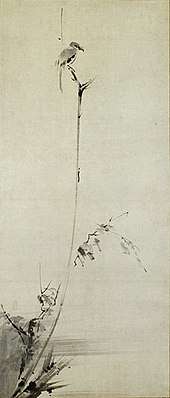
In his later years, Musashi said in his The Book of Five Rings: "When I apply the principle of strategy to the ways of different arts and crafts, I no longer have need for a teacher in any domain." He proved this by creating recognized masterpieces of calligraphy and classic ink painting. His paintings are characterized by skilled use of ink washes and an economy of brush stroke. He especially mastered the "broken ink" school of landscapes, applying it to other subjects, such as his Kobokumeikakuzu ("Shrike Perched on a Withered Branch"; part of a triptych whose other two members were "Hotei Walking" and "Sparrow on Bamboo"), his Hotei Watching a Cockfight, and his Rozanzu ("Wild Geese Among Reeds").
In popular culture
Even in Musashi's time there were fictional texts resembling comic books. It is therefore quite difficult to separate fact from fiction when discussing his life. There have been numerous works of fiction made about or featuring Musashi. Eiji Yoshikawa's novelization (originally a 1930s daily newspaper serial) has greatly influenced successive fictional depictions (including the manga Vagabond by Takehiko Inoue) and is often mistaken for a factual account of Musashi's life. In 2012, writer Sean Michael Wilson and Japanese artist Chie Kutsuwada published an attempt at a more historically accurate manga entitled The Book of Five Rings: A Graphic Novel, based on research and translations by William Scott Wilson. The 2008 video game Yakuza Kenzan was based around his life and personality. He also appeared in the manga Baki-Dou as a revived clone of himself with his real soul intact as one of the strongest fighters in the series, and used his two-sword style in almost every combat in which he was shown.
Bibliography
- Hyodokyo (The Mirror of the Way of Strategy)
- Hyoho Sanjugo Kajo (Thirty-five Instructions on Strategy)
- Hyoho Shijuni Kajo (Forty-two Instructions on Strategy)
- Dokkōdō (The Way to be Followed Alone)
- Go Rin No Sho (The Book of Five Rings; a reference to the Five Rings of Zen Buddhism). Translated into English by Victor Harris as A Book of Five Rings, London: Allison & Busby, 1974; Woodstock, New York: The Overlook Press.
See also
References
- Tokitsu, Kenji (1998). Miyamoto Musashi: 17th century Japanese saber master: man and work, myth and reality ; Miyamoto Musashi : maître de sabre japonais du XVIIe siècle : l'homme et l'œuvre, mythe et réalité. https://www.worldcat.org/oclc/41259596: Editions désiris. pp. 19, 20. ISBN 9782907653541.CS1 maint: location (link)
- Toyota Masataka. "Niten Ki (A Chronicle of Two Heavens)", in Gorin no Sho, ed. Kamiko Tadashi (Tokyo: Tokuma-shoten, 1963), 239.
- Miyamoto Musashi, trans.S. F. Kaufman (1994), Book Of Five Rings, Tuttle Publishing.
- "Budokan". Miyamoto Musashi school. 2009. Retrieved 12 August 2020.
- Miyamoto Musashi. "Go Rin No Sho", in Gorin no Sho, ed. Kamiko Tadashi (Tokyo: Tokuma-shoten, 1963), 13.
- Toyota, p. 239
- Miyamoto, p. 18ff.
- Miyamoto, 13.
- Miyamoto, p. 17ff.
- Kenji Tokitsu (2004). Miyamoto Musashi: His Life and Writings. Shambhala.
- Brant, Miyamoto Musashi; translated by Ashikaga Yoshiharu; edited by Rosemary (2006). The Book of Five Rings: the classic text of Samurai sword strategy (null ed.). New York: Barnes & Noble. ISBN 978-0-7607-8457-0.
- Harris, Victor, p. 10, Miyamoto p. 16ff. The latter footnote by Kamiko reads: "For his entire life, Musashi never took a wife, cut his hair, or entered a bath".
- William Scott Wilson. (2004). The Lone Samurai. Kodansha International. ISBN 978-4-7700-2942-3.
- Lowry, Dave (1986). Bokken: Art of the Japanese Sword. Ohara Publications. p. 21–27. ISBN 978-0-89750-104-0.
- Wilson, William Scott (2004). The Lone Samurai: The Life of Miyamoto Musashi (1st ed.). Tokyo: Kodansha International. p. 19. ISBN 9784770029423.
- "Art of Miyamoto Musashi". Miyamoto Musashi Dojo. 2009. Retrieved 12 August 2020.
- Toyota, p. 250
- "Mimasaka. Musashi Miyamoto". Mémorial Heiho Niten Ichi Ryu. 2018. Retrieved 12 August 2020.
- "宮本武蔵 - Musashi". Miyamoto Musashi dojo. 2009. Retrieved 13 August 2020.
- Almo, Leif. "Musashi Miyamoto - the Legend". Kendo.com. Scandnet AB. Retrieved 4 March 2017.
- Ratti, Oscar; Westbrook, Adele (20 December 2011). Secrets of the Samurai: The Martial Arts of Feudal Japan. Tuttle Publishing. p. 241. ISBN 978-1-4629-0254-5.
- Niten Institute. "The life of Miyamoto Musashi". Instituto Cultural Niten. Retrieved 15 January 2019.
- Hyakutake-Watkin, Colin; Masayuki, Imai; Norikazu, Iwata. "Hyōhō.com". Archived from the original on 15 June 2004.
- Miyamoto, p. 57.
- "獨行道". Archived from the original on 18 December 2008.
Further reading
Fiction
- Sean Michael, Wilson (2014). Musashi (A Graphic Novel). Shambhala. (Manga/historical fiction)
- Sean Michael, Wilson (2012). The Book of Five Rings: a graphic novel. Shambhala. (Manga/historical fiction)
- Inoue, Takehiko (1998). Vagabond. Viz Communications. (Manga/historical fiction)
- Yoshikawa, Eiji (1995). Musashi (reprint ed.). Kodansha International. ISBN 978-4-7700-1957-8. (Historical fiction)
Children's books
- Moore, J.S. (2014). Under the Sun: The Miyamoto Musashi Story. Understanding Apples Press. ISBN 978-1-5028-0491-4.
Essays
- Tokitsu, Kenji (2004). Miyamoto Musashi: His Life and Writings. Shambhala Publications, Inc. ISBN 978-1-59030-045-9.
- Turnbull, Stephen R. (1990). The Lone Samurai and the Martial Arts. London: Arms and Armour Press. ISBN 978-0-85368-967-6.
- Wilson, William Scott (2004). The Lone Samurai. Kodansha International. ISBN 978-4-7700-2942-3.
- De Lange, William (2010). The Real Musashi: The Bushu denraiki. Floating World Editions. ISBN 978-1-891640-56-8.
- De Lange, William (2011). The Real Musashi: The Bukoden. Floating World Editions. ISBN 978-1-891640-60-5.
- De Lange, William (2016). The Real Musashi: A Miscellany. Floating World Editions. ISBN 978-1-891640-86-5.
- De Lange, William (2014). Miyamoto Musashi: A Life in Arms. Floating World Editions. ISBN 978-1-891640-629.
Testimony
- Iwami Toshio Harukatsu soke (11th successor to Miyamoto Musashi), Musashi's teachings – philosophy first: translation in English, Dragon n°7, January 2005, ed. Mathis ; French original text: L'enseignement de Musashi est d'abord une philosophie
- Iwami Toshio Harukatsu soke (11th successor to Miyamoto Musashi), Musashi's principles, Dragon n°13, January 2006, ed. Mathis; French original text: Les principes de Musashi
External links
| Library resources about Miyamoto Musashi |
| By Miyamoto Musashi |
|---|

.svg.png)